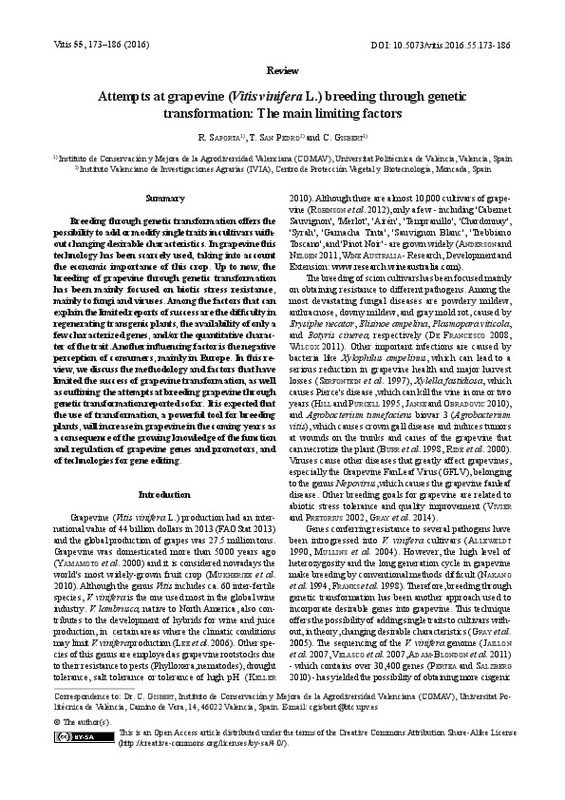JavaScript is disabled for your browser. Some features of this site may not work without it.
Buscar en RiuNet
Listar
Mi cuenta
Estadísticas
Ayuda RiuNet
Admin. UPV
Attempts at grapevine (Vitis vinifera L.) breeding through genetic transformation: The main limiting factors
Mostrar el registro sencillo del ítem
Ficheros en el ítem
| dc.contributor.author | Saporta, Rubén
|
es_ES |
| dc.contributor.author | San Pedro-Galan, Tania
|
es_ES |
| dc.contributor.author | Gisbert Domenech, María Carmen
|
es_ES |
| dc.date.accessioned | 2018-02-13T08:58:52Z | |
| dc.date.available | 2018-02-13T08:58:52Z | |
| dc.date.issued | 2016 | es_ES |
| dc.identifier.issn | 0042-7500 | es_ES |
| dc.identifier.uri | http://hdl.handle.net/10251/97803 | |
| dc.description.abstract | [EN] Breeding through genetic transformation offers the possibility to add or modify single traits in cultivars without changing desirable characteristics. In grapevine this technology has been scarcely used, taking into account the economic importance of this crop. Up to now, the breeding of grapevine through genetic transformation has been mainly focused on biotic stress resistance, mainly to fungi and viruses. Among the factors that can explain the limited reports of success are the difficulty in regenerating transgenic plants, the availability of only a few characterized genes, and/or the quantitative character of the trait. Another influencing factor is the negative perception of consumers, mainly in Europe. In this review, we discuss the methodology and factors that have limited the success of grapevine transformation, as well as outlining the attempts at breeding grapevine through genetic transformation reported so far. It is expected that the use of transformation, a powerful tool for breeding plants, will increase in grapevine in the coming years as a consequence of the growing knowledge of the function and regulation of grapevine genes and promotors, and of technologies for gene editing. | es_ES |
| dc.description.sponsorship | This work was supported by the project CGL2015-70843-R (Ministerio de Economia y Competitividad de Espana), co-funded with FEDER funds. We thank Dr. D. WALKER for the revision of the written English in the manuscript. T. SAN PEDRO has a grant (01/14-FSE-22) supported by the IVIA institute. | |
| dc.language | Inglés | es_ES |
| dc.publisher | Julius Kühn-Institut Institute for Grapevine Breeding | es_ES |
| dc.relation.ispartof | VITIS | es_ES |
| dc.rights | Reconocimiento - Compartir igual (by-sa) | es_ES |
| dc.subject.classification | GENETICA | es_ES |
| dc.title | Attempts at grapevine (Vitis vinifera L.) breeding through genetic transformation: The main limiting factors | es_ES |
| dc.type | Artículo | es_ES |
| dc.identifier.doi | 10.5073/vitis.2016.55.173-186 | es_ES |
| dc.relation.projectID | info:eu-repo/grantAgreement/MINECO//CGL2015-70843-R/ES/DESARROLLO DE PROTOCOLOS DE CONSERVACION IN VITRO Y DE CRIOCONSERVACION DE GERMOPLASMA DE VID: ANALISIS DE LA VARIABILIDAD Y CONSERVACION DE PORTAINJERTOS Y VARIEDADES MINORIT/ | es_ES |
| dc.rights.accessRights | Abierto | es_ES |
| dc.contributor.affiliation | Universitat Politècnica de València. Departamento de Biotecnología - Departament de Biotecnologia | es_ES |
| dc.description.bibliographicCitation | Saporta, R.; San Pedro-Galan, T.; Gisbert Domenech, MC. (2016). Attempts at grapevine (Vitis vinifera L.) breeding through genetic transformation: The main limiting factors. VITIS. 55(4):173-186. https://doi.org/10.5073/vitis.2016.55.173-186 | es_ES |
| dc.description.accrualMethod | S | es_ES |
| dc.relation.publisherversion | http://doi.org/10.5073/vitis.2016.55.173-186 | es_ES |
| dc.description.upvformatpinicio | 173 | es_ES |
| dc.description.upvformatpfin | 186 | es_ES |
| dc.type.version | info:eu-repo/semantics/publishedVersion | es_ES |
| dc.description.volume | 55 | es_ES |
| dc.description.issue | 4 | es_ES |
| dc.relation.pasarela | S\320354 | es_ES |
| dc.contributor.funder | Ministerio de Economía, Industria y Competitividad | es_ES |








